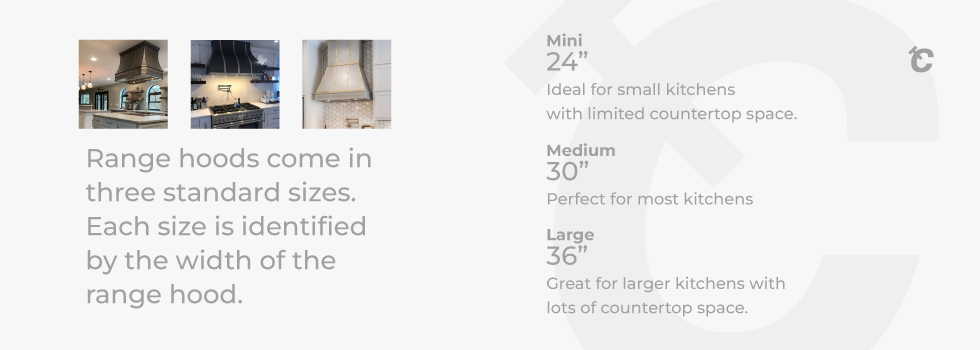
When buying range hoods, you want to get the best value for your money.
How big should my range hood be? The answer depends on several factors, such as where you live, how much space you have, and whether or not you plan to install it permanently.
A kitchen ventilation hood is a kitchen appliance designed to remove grease from cooking fumes before they reach the air ducts. They also reduce unpleasant odors, smoke, and harmful pollutants such as carbon monoxide. And, they're essential for proper ventilation in your kitchen.
Range hoods come in three basic sizes: mini, medium, and large. Each size has its advantages and disadvantages. For example, a larger model will cover a wider area, but cleaning might take longer. If you don't have enough room for a full-size unit, consider a smaller model instead.
Deciding between these different sizes can seem confusing. But we're here to help.
Below, you'll find a comprehensive guide on figuring out how big your new range hood should be.
Standard Range Hood Dimensions
Range hoods come in three standard sizes. Each size is identified by the width of the range hood. Those widths are:
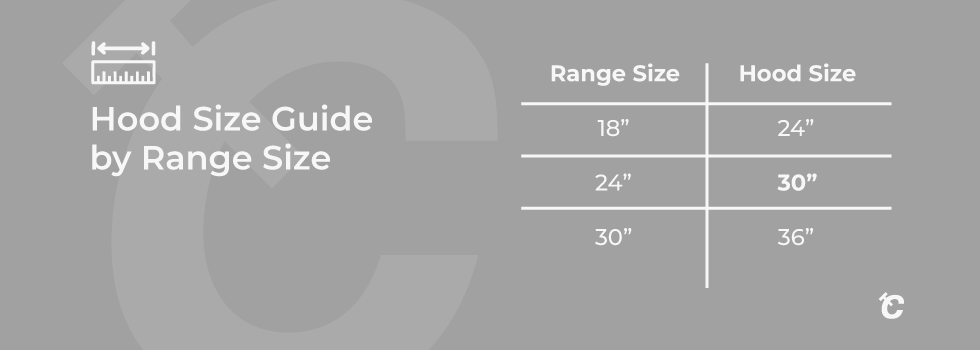
The smallest (mini) range hoods measure 24 inches wide. These models are ideal for small kitchens with limited countertop space. Mini range hoods are compact, so they won't take up too much space. They're also easy to move around when needed.
Medium range hoods measure 30 inches wide. This size is perfect for most kitchens. It's a good choice for homes needing more storage or other storage space.
Large range hoods measure 36 inches wide. These units are great for larger kitchens with lots of countertop space. Larger models are easier to clean because they hold more debris. However, they may require more maintenance than smaller models.
Your vent hood should be several inches wider than your cooking surface. Gas cooktops and electric ranges alike require spacious ventilation hoods above them to capture fumes and cooking odors.
For highly specific needs, World CopperSmith also has custom range options for you to consider, should the standard range hood sizes not suit your kitchen.
Hood Size Guide by Range Size
The size of the kitchen hood you require to keep your kitchen air clean depends on your electric cooktop or gas stove size.
A good rule of thumb is that your hood should be at least six inches wider than your range. Below is some insight into the range vs. hood size to help you when selecting one.
|
Range Size |
Hood Size |
|
18" |
24" |
|
24" |
30" |
|
30" |
36" |
A good rule of thumb is that your hood should be 24", 30", or 36" if you have an electric cooktop.
If you have a gas cooktop, this means your hood should be 24" or 30".
You may also want to consider adding a second hood over your main one. This way, you can use both together when needed.
This is especially important if you have multiple cooks in your home. It's also helpful if you have a lot of pots and pans heating up at once.
This is because each person using the oven will create more heat, which could cause problems with the other appliances in your kitchen.
Check out this blog more information on range hood depth.
Range Hood Placements
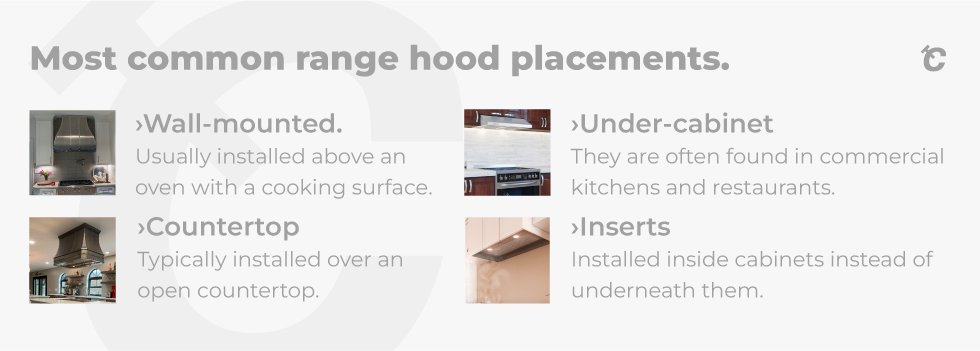
A range hood is a device that removes smoke and fumes from cooking appliances such as stoves or ovens using charcoal filters. It also helps keep kitchens clean by removing grease and odors.
Range hoods are available in different sizes, shapes, and styles, but they all work on the same principle. They have a fan that pulls air through filters, which remove particles like dust, dirt, and bacteria. This filtered air then flows back into the kitchen where it can be recirculated.
You can place your new range hoods in several places depending on your cooking surface, cooking space, cooking style, and cooking habits.
This section will cover some of the most common range hood placements.
Island mounted range hoods
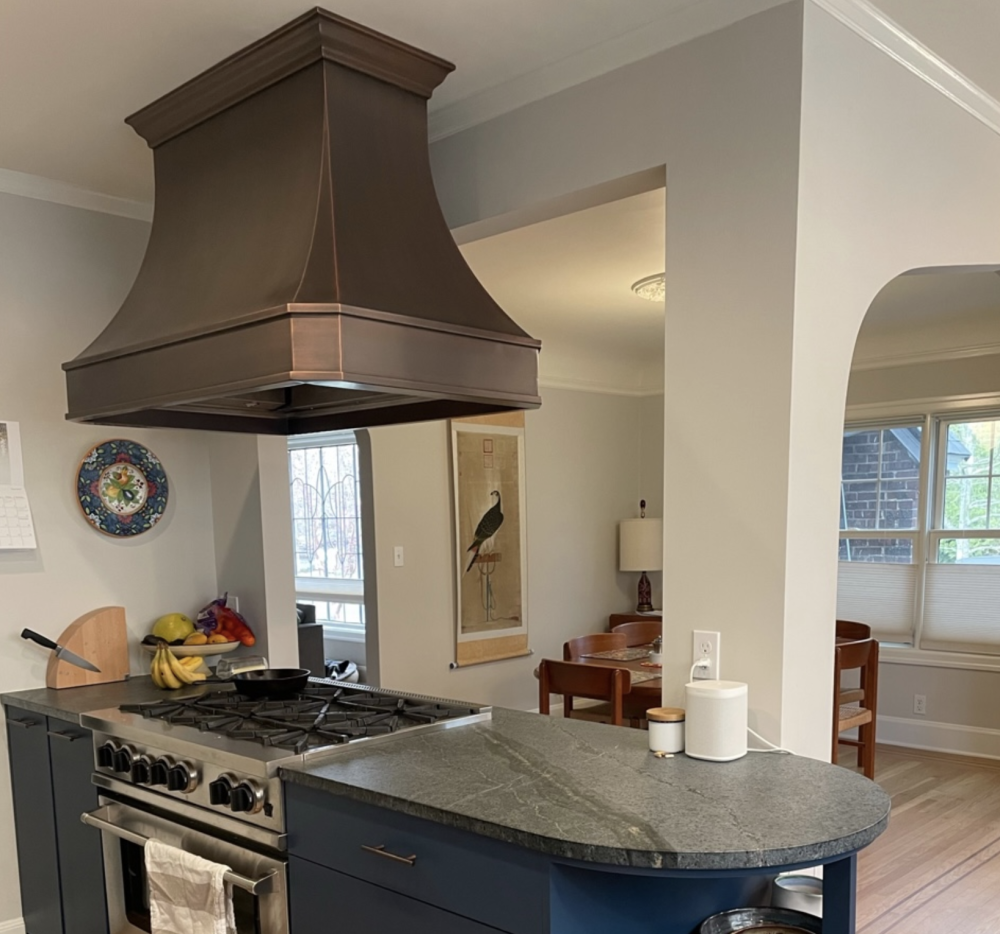
Island-mounted range hoods are designed for use in kitchens with limited space. They usually consist of an exhaust fan that is located above an island cooktop.
Island range hoods are most commonly used in small spaces because they do not obstruct the view of the cooktop. Although, if you need more space than what an island mount provides, you may want to look at other types of range hoods.
Wall-mounted range hoods
Wall-mounted hoods are designed for use in kitchens with walls on all sides. They are usually installed above an oven with a cooking surface but can be placed where there are hot cooking fumes.
The advantage of wall-mounted units is that they provide additional space for storage and counter space. They are also easier to move around when needed.
Countertop range hoods
If you have plenty of counter space, you may want to choose a countertop range hood. These models are typically installed over an open countertop.
Countertop range hoods are easy to access and are less expensive than their wall-mounted counterparts.
Under-cabinet range hoods
An under-cabinet range hood is a good option for people who prefer to cook in tight quarters. They are often found in commercial kitchens and restaurants.
Because they are hidden away, cabinet hoods are ideal for people who dislike being seen while cooking. Under cabinet, range hoods are also very convenient because they allow cooks to easily reach food without standing up.
Range hood inserts
Range hood inserts are similar to under-cabinet models except that they are installed inside cabinets instead of underneath them.
These models are perfect for people who don't mind having their cooking equipment visible. Range hood inserts are also easier to install than other range hood options.
Your choice of range hood depends on how much space you have, whether you prefer to stand while cooking, and how much money you're willing to spend.
Custom Hood Options

World CoppeSmith offers a wide variety of custom hood options. If you have a unique design or need something special, our team will be happy to help you create the perfect range hood to suit your kitchen design needs.
Types of Range Hoods
In addition to size, it's important to know what type of range hood you want. There are two different types of ventilation hoods on the market: recirculating range hoods, also known as ductless range hoods, and exhaust hoods, also called ducted hoods.
Choosing between these two range hood styles depends on your specific needs. Though picking the right type of range hood can seem daunting, it comes down to a few simple factors.
Recirculating range hoods
Recirculating range hoods use an exhaust fan to pull in fresh outside air into the kitchen. This allows for better ventilation than traditional range hoods that draw in only stale indoor air. Recirculating range hoods also filter the air before returning it to the kitchen.
Ductless range hoods are typically more expensive than their exhaust counterparts because they are made of higher quality materials. However, they do not require any ductwork, making installation easier and cheaper.
Exhaust range hoods
Exhaust range hoods are designed for use in high-humidity kitchens. They remove moisture and odors from cooking fumes before they reach the ventilation system. Powerful range hoods that use the exhaust model are often used in commercial kitchens with high humidity levels.
Like other vent hoods, ducted range hoods rely on range hood fans to pull in air and fumes. However, they tend to make more noise than their ductless counterparts. If you're considering an exhaust hood, make sure you're ok with the noise level it could bring.
Vent Hood Installation Tips
Installing a kitchen range hood is easy if you follow some basic guidelines.
First, make sure you measure the height of your ceiling correctly using a measuring tape. If you don't, you may end up installing a range hood that doesn't fit properly.
Next, check the location of the electrical outlets. You'll need at least one outlet within 12 inches of the range hood to plug in power tools.
Finally, ensure there is enough clearance between the range hood and other cabinets and appliances. The minimum recommended distance is 18 inches of space.
You should ensure that any vent hood installation complies with local building codes before you start working.
Additionally, use caution when working around gas stoves. Take care to maintain the integrity of any gas lines supplying your gas ranges.
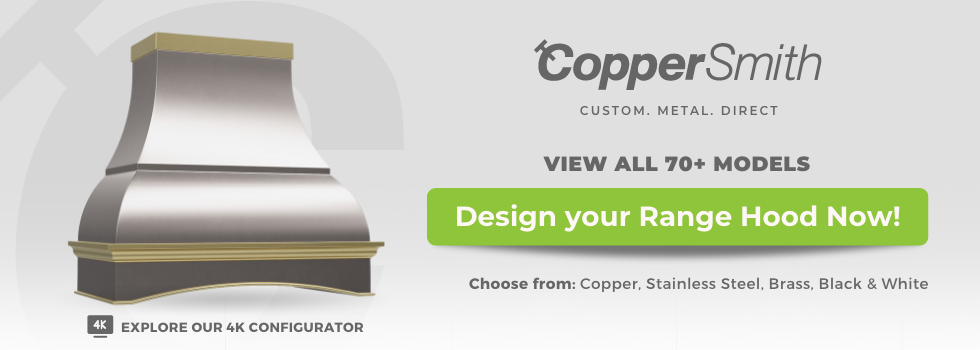
Conclusion
The best hoods blend your practical needs with your design choices. Luckily, vent hoods come in a variety of styles.
Consider your budget, style preferences, and personal taste when choosing a range hood. A good rule of thumb is to choose the best option available based on your needs.
Vent hoods are essential parts of your kitchen set-up. So, don't skimp or skip when it comes to your new range hood.
Ready to purchase a stylish new range hood for your home or commercial kitchen?
World CopperSmith can help, as we have white range hoods of all sizes, finishes, and styles.
World CopperSmith is an international leader in custom metal work and home finishings. Let us help you find your new vent hood.
Visit our website and browse our wide selection of range hoods today.
